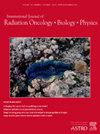乳腺癌低分次全乳放射治疗与同步综合增强:HYPOSIB-试验的初步分析(ARO 2013-05)
IF 6.4
1区 医学
Q1 ONCOLOGY
International Journal of Radiation Oncology Biology Physics
Pub Date : 2024-10-01
DOI:10.1016/j.ijrobp.2024.07.005
引用次数: 0
摘要
目的/目标:适度低分次(HF)被认为是保乳手术(BCS)后乳腺癌患者辅助全乳放疗的标准治疗方法。建立 HF 的试验采用的是肿瘤床序贯增强疗法(seqB)。之前的研究已对常规分次同时综合增强(SIB)放疗进行了研究。HYPOSIB试验(NCT02474641)是使用SIB研究高频放疗的三项大型试验之一。材料/方法HYPOSIB是一项随机对照、欧洲多中心、非劣效试验。试验以 1:1 随机分配到试验组(乳腺 40 Gy,肿瘤床 48 Gy,16 次分割)或对照组(由医生选择常规分割与 SIB 或 seqB,或 HF 与 seqB)。主要终点是无病生存期(DFS)。试验开始时,假设对照组的 5 年无病生存率为 86.4%,非劣效边际为 5%(危险比 [HR] = 1.42)。在盲法中期分析显示事件少于预期后,设计改为在最后一名患者入组 3 年后进行时间驱动分析,HR 的非劣效界值调整为 1.757。次要终点为局部控制、局部区域控制、总生存期、毒性、生活质量和外观。结果2015年至2019年间,共有2310名患者接受了随机治疗,其中2179名患者按照方案接受了治疗,并参与了本次分析。中位随访时间为 52.9 个月(范围 = 42.0-61.7 个月)。有 141 名患者至少有一次 DFS 事件,其中 75 人属于实验组。31例患者出现局部复发,其中16例为实验组患者。实验组 5 年的 DFS 为 92.0%(95% 置信区间 [CI] = 89.9-93.6%),对照组为 92.2%(95% CI = 89.9-94.0%)(HR = 1.10;95% CI = 0.78-1.54;P = 0.58)。因此,实验组的非劣效性成立。5年后,实验组的局部控制率为98.2%(95% CI = 97.0-98.9%),对照组为98.0%(95% CI = 96.4-98.9%)(HR = 1.08;95% CI = 0.51-2.27;P = 0.84)。实验组的 5 年总生存率为 98.2% (95% CI = 96.9-98.9%),标准组为 97.9% (95% CI = 96.5-98.7%)(HR = 0.78; 95% CI = 0.39-1.55; P = 0.48)。5年后≥2级纤维化的累积发生率,实验组为7.3%,实验组为8.4%(几率比=0.86;95% CI = 0.63-1.16;P = 0.32)。结论结合 IMPORT HIGH 和 RTOG 1005 的研究结果,HYPOSIB 的结果表明,使用 SIB 的高频可被视为 BCS 后辅助放疗的标准治疗方法。本文章由计算机程序翻译,如有差异,请以英文原文为准。
Hypofractionated Whole-Breast Irradiation with Simultaneous Integrated Boost for Breast Cancer: Primary Analysis of the HYPOSIB-Trial (ARO 2013-05)
Purpose/Objective(s)
Moderate hypofractionation (HF) is considered standard of care for adjuvant whole-breast radiotherapy in patients with breast cancer after breast-conserving surgery (BCS). The trials establishing HF used a sequential tumor bed boost (seqB). Prior studies have studied simultaneous integrated boost (SIB)-irradiation with conventional fractionation. The HYPOSIB-trial (NCT02474641) is one of three large trials that studied HF with SIB. Results for acute toxicity have been presented at a prior ASTRO-meeting and favored HF with SIB.
Materials/Methods
HYPOSIB is a randomized-controlled, European, multi-center, non-inferiority trial. Randomization was performed 1:1 to the experimental arm (40 Gy to the breast and 48 Gy to the tumor bed in 16 fractions) or to the control arm (physician’s choice between conventional fractionation with SIB or seqB, or HF with seqB). The primary endpoint was disease-free survival (DFS). At trial initiation, a DFS of 86.4% at 5 years was assumed in the control arm with a non-inferiority margin of 5% (hazard ratio [HR] = 1.42). After a blinded interim analysis showed fewer events than expected, the design was changed to a time-driven analysis 3 years after enrollment of the final patient with an adapted non-inferiority boundary for the HR of 1.757. Secondary endpoints were local control, locoregional control, overall survival, toxicity, quality of life, and cosmesis.
Results
Between 2015 and 2019, a total of 2310 patients were randomized, of which 2179 were treated according to protocol and were part of this analysis. Median follow-up was 52.9 months (range = 42.0-61.7 months). There were 141 patients who had at least one DFS-event, of which 75 were in the experimental arm. Local recurrence occurred in 31 patients, of which 16 were in the experimental arm. DFS at 5 years was 92.0% (95% confidence interval [CI] = 89.9-93.6%) in the experimental arm and 92.2% (95% CI = 89.9-94.0%) in the control arm (HR = 1.10; 95% CI = 0.78-1.54; P = 0.58). Thus, non-inferiority of the experimental arm was established. Local control at 5 years was 98.2% (95% CI = 97.0-98.9%) in the experimental arm and 98.0% (95% CI = 96.4-98.9%) in the control arm (HR = 1.08; 95% CI = 0.51-2.27; P = 0.84). Overall survival at 5 years was 98.2% (95% CI = 96.9-98.9%) in the experimental arm and 97.9% (95% CI = 96.5-98.7%) in the standard arm (HR = 0.78; 95% CI = 0.39-1.55; P = 0.48). Cumulative incidence of grade ≥ 2 fibrosis at 5 years was 7.3% in the experimental arm and 8.4% in the experimental arm (odds ratio = 0.86; 95% CI = 0.63-1.16; P = 0.32). Telangiectasia grade ≥ 2 had occurred in 1.5% in the experimental arm and 1.5% in the control arm at 5 years (OR = 0.97; 95% CI = 0.50-1.88; P = 0.92).
Conclusion
Together with the findings of IMPORT HIGH and RTOG 1005, the results of HYPOSIB demonstrate that HF with SIB can be considered a standard of care for adjuvant radiotherapy after BCS.
求助全文
通过发布文献求助,成功后即可免费获取论文全文。
去求助
来源期刊
CiteScore
11.00
自引率
7.10%
发文量
2538
审稿时长
6.6 weeks
期刊介绍:
International Journal of Radiation Oncology • Biology • Physics (IJROBP), known in the field as the Red Journal, publishes original laboratory and clinical investigations related to radiation oncology, radiation biology, medical physics, and both education and health policy as it relates to the field.
This journal has a particular interest in original contributions of the following types: prospective clinical trials, outcomes research, and large database interrogation. In addition, it seeks reports of high-impact innovations in single or combined modality treatment, tumor sensitization, normal tissue protection (including both precision avoidance and pharmacologic means), brachytherapy, particle irradiation, and cancer imaging. Technical advances related to dosimetry and conformal radiation treatment planning are of interest, as are basic science studies investigating tumor physiology and the molecular biology underlying cancer and normal tissue radiation response.

 求助内容:
求助内容: 应助结果提醒方式:
应助结果提醒方式:


